Unit 12: Organizational Behavior Analysis & Performance Report
VerifiedAdded on 2021/07/14
|24
|4763
|39
Report
AI Summary
This report, prepared by a junior assistant at McKinsey & Company, provides a comprehensive analysis of organizational behavior. It examines the influence of organizational culture, politics, and power on individual and team performance, referencing Hendy's model and Hofstede's Cultural Dimension theory. The report delves into motivation theories, including Maslow's Hierarchy, Two-Factor Theory, and Vroom's Expectancy theory, exploring their application in achieving organizational goals. It also discusses effective team dynamics, team development theories, and the practical application of organizational behavior concepts within a business context. The report concludes with insights into how these concepts inform and influence behavior, aiming to provide valuable research for the firm's future endeavors.

Unit 12
Organizational Behaviour
Student Name:
Student ID:
1 | P a g e
Organizational Behaviour
Student Name:
Student ID:
1 | P a g e
Paraphrase This Document
Need a fresh take? Get an instant paraphrase of this document with our AI Paraphraser

Table of Contents
Introduction:....................................................................................................................................4
LO1:.................................................................................................................................................5
1.1 Organization’s culture, politics, and power & their influence on individual and team
behavior and performance:..........................................................................................................5
1.1.1 Effect of organizational culture:.....................................................................................5
1.1.2 Influence of Organizational Politics:..............................................................................6
1.1.3 Organizational Power influence:....................................................................................6
1.2 Analysation of the culture, politics, and power of an organization can influence individual
and team behavior and performance:...........................................................................................7
1.2.1 Influence of organizational culture on individual and team behavior............................7
1.2.2 Influence of organizational politics and power:.............................................................9
LO2:...............................................................................................................................................10
2.1 How Theories of Motivation and techniques enable effectiveness in achieving goals of the
organization:..............................................................................................................................10
2.1.1 Content Theory:............................................................................................................10
2.1.2 Process Theory:............................................................................................................12
2.2 Ways of influencing the behavior of others through the practical application of behavioral,
motivational theories & models:................................................................................................13
2.2.1 implications of the motivational theory of leadership within organizations:...............13
LO3:...............................................................................................................................................15
3.1 What makes an effective team as opposed to an ineffective team:.....................................15
3.1.1 Factors behind making the team effective or ineffective..............................................15
3.1.2 Types of Organizational Teams:...................................................................................15
3.2 Relevant team and group development theories to support the development of cooperation
within effective teams:...............................................................................................................16
2 | P a g e
Introduction:....................................................................................................................................4
LO1:.................................................................................................................................................5
1.1 Organization’s culture, politics, and power & their influence on individual and team
behavior and performance:..........................................................................................................5
1.1.1 Effect of organizational culture:.....................................................................................5
1.1.2 Influence of Organizational Politics:..............................................................................6
1.1.3 Organizational Power influence:....................................................................................6
1.2 Analysation of the culture, politics, and power of an organization can influence individual
and team behavior and performance:...........................................................................................7
1.2.1 Influence of organizational culture on individual and team behavior............................7
1.2.2 Influence of organizational politics and power:.............................................................9
LO2:...............................................................................................................................................10
2.1 How Theories of Motivation and techniques enable effectiveness in achieving goals of the
organization:..............................................................................................................................10
2.1.1 Content Theory:............................................................................................................10
2.1.2 Process Theory:............................................................................................................12
2.2 Ways of influencing the behavior of others through the practical application of behavioral,
motivational theories & models:................................................................................................13
2.2.1 implications of the motivational theory of leadership within organizations:...............13
LO3:...............................................................................................................................................15
3.1 What makes an effective team as opposed to an ineffective team:.....................................15
3.1.1 Factors behind making the team effective or ineffective..............................................15
3.1.2 Types of Organizational Teams:...................................................................................15
3.2 Relevant team and group development theories to support the development of cooperation
within effective teams:...............................................................................................................16
2 | P a g e
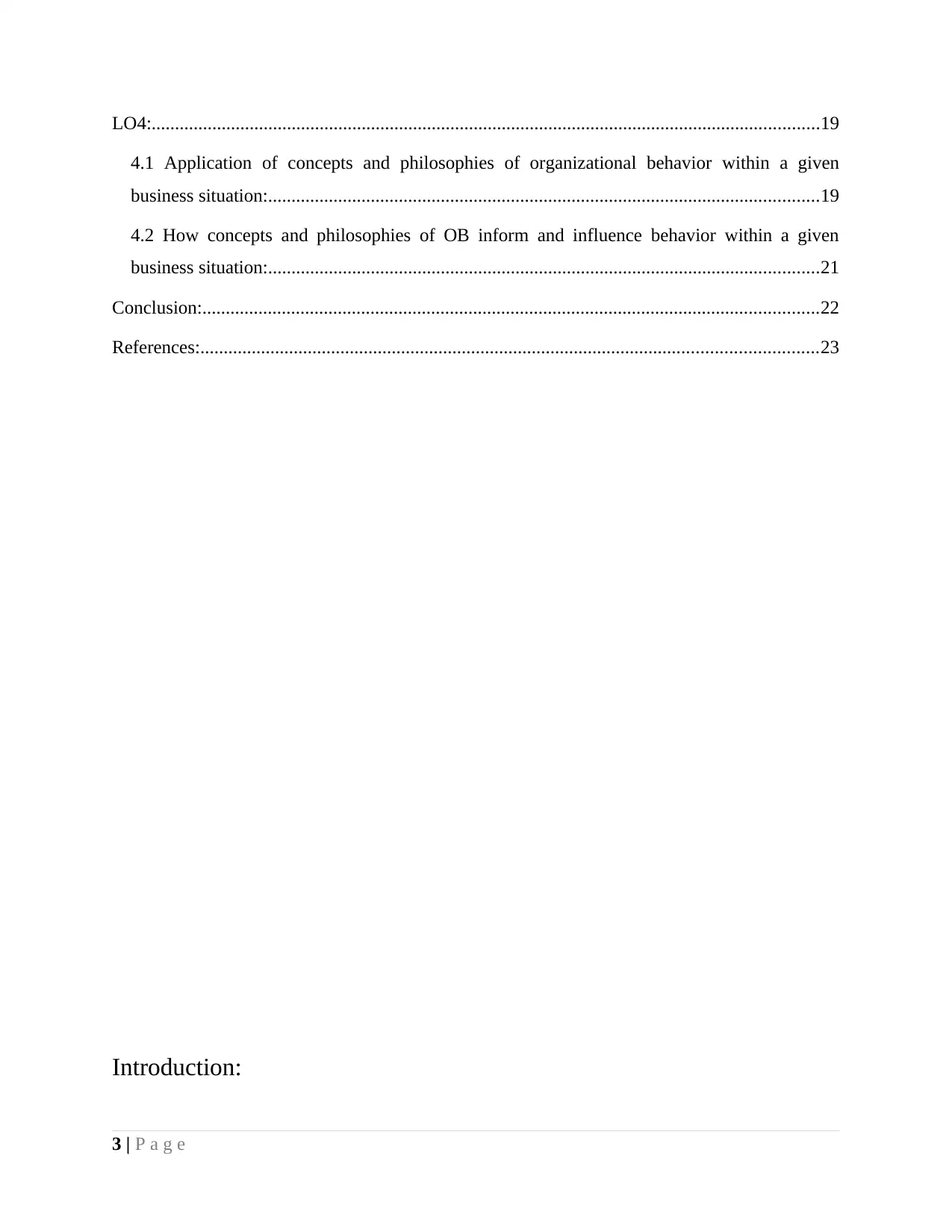
LO4:...............................................................................................................................................19
4.1 Application of concepts and philosophies of organizational behavior within a given
business situation:......................................................................................................................19
4.2 How concepts and philosophies of OB inform and influence behavior within a given
business situation:......................................................................................................................21
Conclusion:....................................................................................................................................22
References:....................................................................................................................................23
Introduction:
3 | P a g e
4.1 Application of concepts and philosophies of organizational behavior within a given
business situation:......................................................................................................................19
4.2 How concepts and philosophies of OB inform and influence behavior within a given
business situation:......................................................................................................................21
Conclusion:....................................................................................................................................22
References:....................................................................................................................................23
Introduction:
3 | P a g e
⊘ This is a preview!⊘
Do you want full access?
Subscribe today to unlock all pages.

Trusted by 1+ million students worldwide

Organizational behavior is an essential topic that helps any organization operate its activities
efficiently and manage the employees' roles (Afzal et al., 2019). Organizational behavior defines
the way of conduct of management and employees. Organizational behavior involves various
terms like organization’s politics, culture, and application of power as well. Without establishing
good corporate behavior, the success of an organization lags far behind. For this assignment, I
have been selected as a Junior assistance in Mckinsey & Company, and I have to present my
research variables to the firm for their future endeavor. This study will also reflect on the
practical research methods regarding the behavioral approaches of organizations & how they
provide exposure to their organization by using these. We will also discuss the benefits of
teamwork and how teamwork can be enabled within an organization using different theories.
LO1:
1.1 Organization’s culture, politics, and power & their influence on individual and team
behavior and performance:
1.1.1 Effect of organizational culture:
When we hear about organizational culture, we reflect on the employees' behaviors, conduct,
vision, norms, and beliefs within an organization. It also shows the way of their achieving goals.
4 | P a g e
efficiently and manage the employees' roles (Afzal et al., 2019). Organizational behavior defines
the way of conduct of management and employees. Organizational behavior involves various
terms like organization’s politics, culture, and application of power as well. Without establishing
good corporate behavior, the success of an organization lags far behind. For this assignment, I
have been selected as a Junior assistance in Mckinsey & Company, and I have to present my
research variables to the firm for their future endeavor. This study will also reflect on the
practical research methods regarding the behavioral approaches of organizations & how they
provide exposure to their organization by using these. We will also discuss the benefits of
teamwork and how teamwork can be enabled within an organization using different theories.
LO1:
1.1 Organization’s culture, politics, and power & their influence on individual and team
behavior and performance:
1.1.1 Effect of organizational culture:
When we hear about organizational culture, we reflect on the employees' behaviors, conduct,
vision, norms, and beliefs within an organization. It also shows the way of their achieving goals.
4 | P a g e
Paraphrase This Document
Need a fresh take? Get an instant paraphrase of this document with our AI Paraphraser
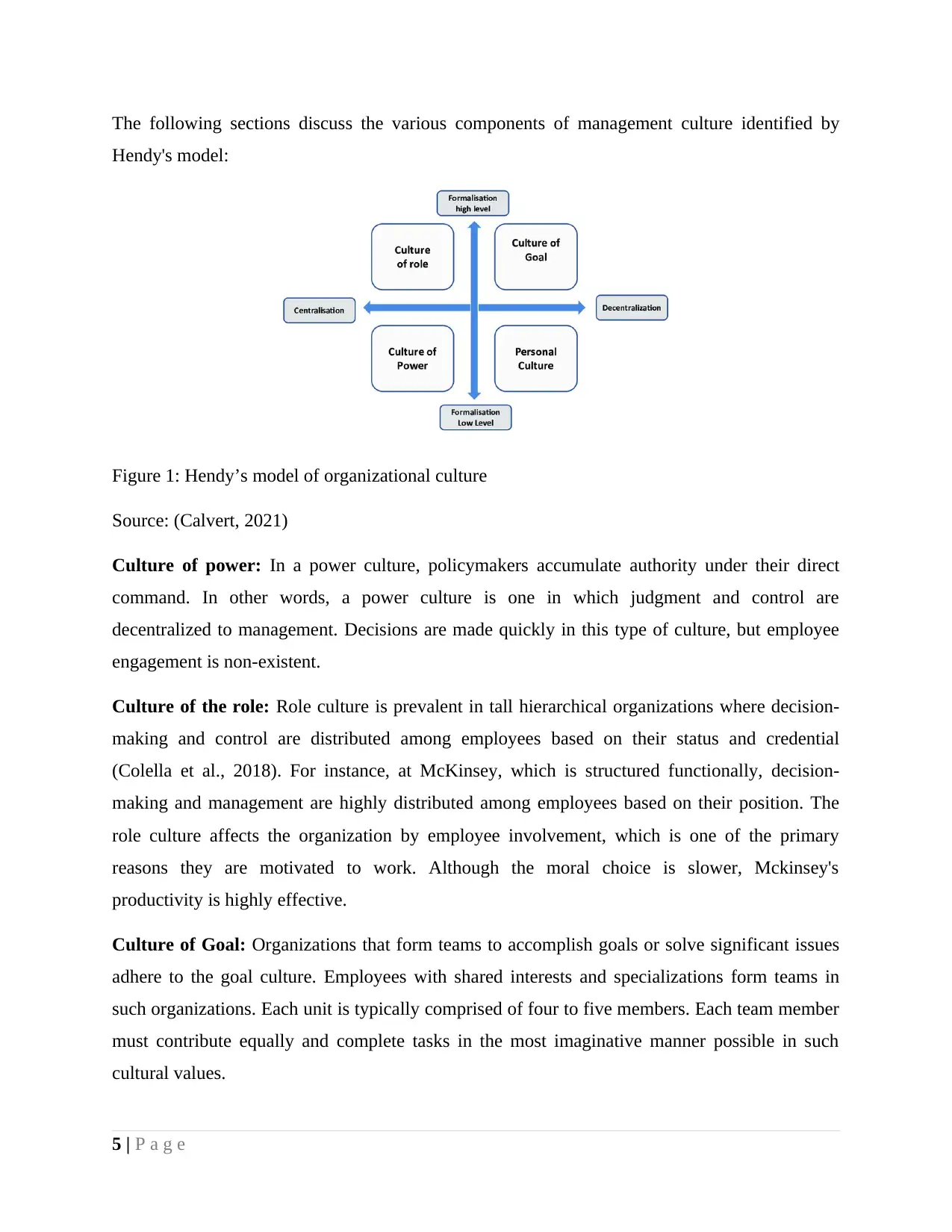
The following sections discuss the various components of management culture identified by
Hendy's model:
Figure 1: Hendy’s model of organizational culture
Source: (Calvert, 2021)
Culture of power: In a power culture, policymakers accumulate authority under their direct
command. In other words, a power culture is one in which judgment and control are
decentralized to management. Decisions are made quickly in this type of culture, but employee
engagement is non-existent.
Culture of the role: Role culture is prevalent in tall hierarchical organizations where decision-
making and control are distributed among employees based on their status and credential
(Colella et al., 2018). For instance, at McKinsey, which is structured functionally, decision-
making and management are highly distributed among employees based on their position. The
role culture affects the organization by employee involvement, which is one of the primary
reasons they are motivated to work. Although the moral choice is slower, Mckinsey's
productivity is highly effective.
Culture of Goal: Organizations that form teams to accomplish goals or solve significant issues
adhere to the goal culture. Employees with shared interests and specializations form teams in
such organizations. Each unit is typically comprised of four to five members. Each team member
must contribute equally and complete tasks in the most imaginative manner possible in such
cultural values.
5 | P a g e
Hendy's model:
Figure 1: Hendy’s model of organizational culture
Source: (Calvert, 2021)
Culture of power: In a power culture, policymakers accumulate authority under their direct
command. In other words, a power culture is one in which judgment and control are
decentralized to management. Decisions are made quickly in this type of culture, but employee
engagement is non-existent.
Culture of the role: Role culture is prevalent in tall hierarchical organizations where decision-
making and control are distributed among employees based on their status and credential
(Colella et al., 2018). For instance, at McKinsey, which is structured functionally, decision-
making and management are highly distributed among employees based on their position. The
role culture affects the organization by employee involvement, which is one of the primary
reasons they are motivated to work. Although the moral choice is slower, Mckinsey's
productivity is highly effective.
Culture of Goal: Organizations that form teams to accomplish goals or solve significant issues
adhere to the goal culture. Employees with shared interests and specializations form teams in
such organizations. Each unit is typically comprised of four to five members. Each team member
must contribute equally and complete tasks in the most imaginative manner possible in such
cultural values.
5 | P a g e
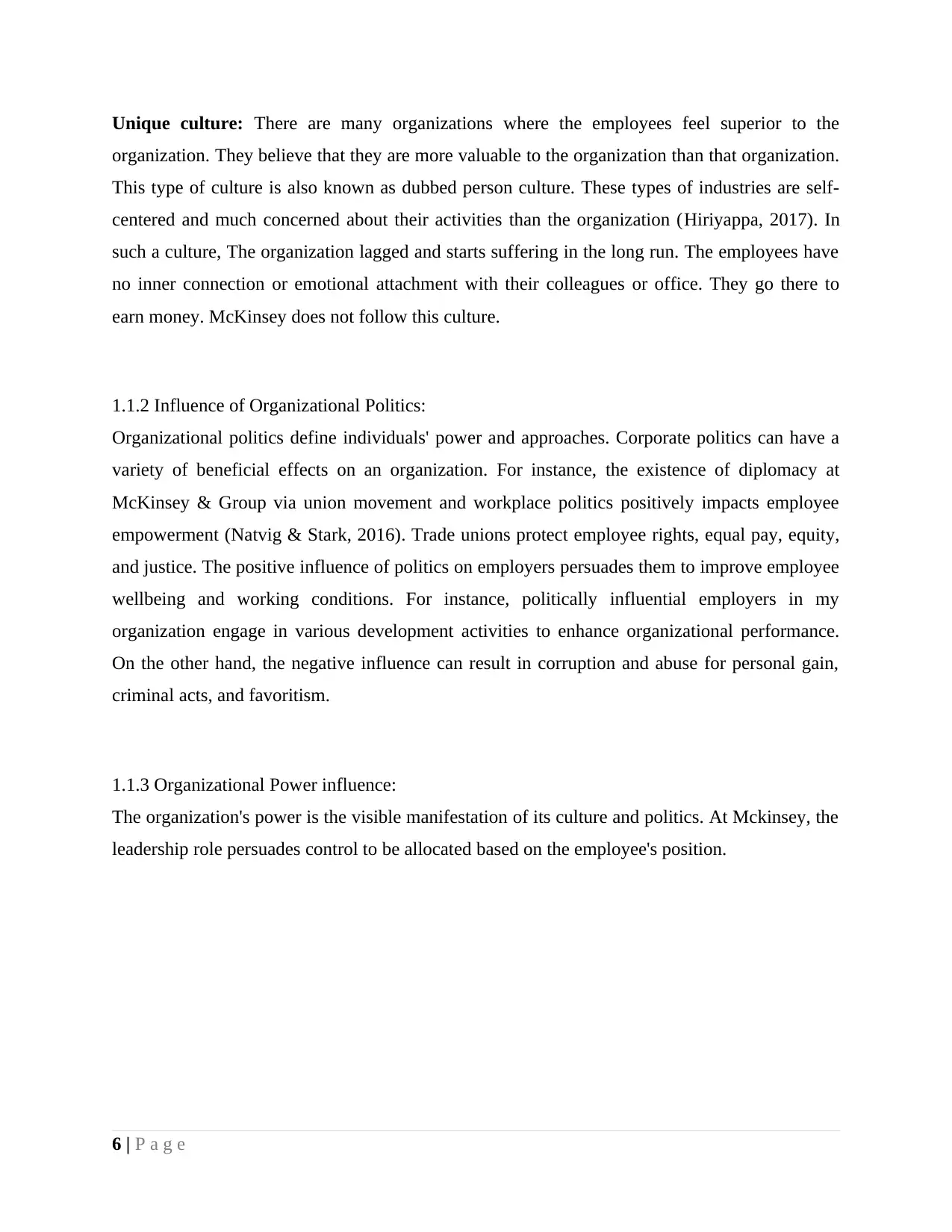
Unique culture: There are many organizations where the employees feel superior to the
organization. They believe that they are more valuable to the organization than that organization.
This type of culture is also known as dubbed person culture. These types of industries are self-
centered and much concerned about their activities than the organization (Hiriyappa, 2017). In
such a culture, The organization lagged and starts suffering in the long run. The employees have
no inner connection or emotional attachment with their colleagues or office. They go there to
earn money. McKinsey does not follow this culture.
1.1.2 Influence of Organizational Politics:
Organizational politics define individuals' power and approaches. Corporate politics can have a
variety of beneficial effects on an organization. For instance, the existence of diplomacy at
McKinsey & Group via union movement and workplace politics positively impacts employee
empowerment (Natvig & Stark, 2016). Trade unions protect employee rights, equal pay, equity,
and justice. The positive influence of politics on employers persuades them to improve employee
wellbeing and working conditions. For instance, politically influential employers in my
organization engage in various development activities to enhance organizational performance.
On the other hand, the negative influence can result in corruption and abuse for personal gain,
criminal acts, and favoritism.
1.1.3 Organizational Power influence:
The organization's power is the visible manifestation of its culture and politics. At Mckinsey, the
leadership role persuades control to be allocated based on the employee's position.
6 | P a g e
organization. They believe that they are more valuable to the organization than that organization.
This type of culture is also known as dubbed person culture. These types of industries are self-
centered and much concerned about their activities than the organization (Hiriyappa, 2017). In
such a culture, The organization lagged and starts suffering in the long run. The employees have
no inner connection or emotional attachment with their colleagues or office. They go there to
earn money. McKinsey does not follow this culture.
1.1.2 Influence of Organizational Politics:
Organizational politics define individuals' power and approaches. Corporate politics can have a
variety of beneficial effects on an organization. For instance, the existence of diplomacy at
McKinsey & Group via union movement and workplace politics positively impacts employee
empowerment (Natvig & Stark, 2016). Trade unions protect employee rights, equal pay, equity,
and justice. The positive influence of politics on employers persuades them to improve employee
wellbeing and working conditions. For instance, politically influential employers in my
organization engage in various development activities to enhance organizational performance.
On the other hand, the negative influence can result in corruption and abuse for personal gain,
criminal acts, and favoritism.
1.1.3 Organizational Power influence:
The organization's power is the visible manifestation of its culture and politics. At Mckinsey, the
leadership role persuades control to be allocated based on the employee's position.
6 | P a g e
⊘ This is a preview!⊘
Do you want full access?
Subscribe today to unlock all pages.

Trusted by 1+ million students worldwide

Figure 2: Relationship among corporate power interest & politics:
Source: (Hiriyappa, 2017).
Employees are accountable to the departmentalization official in charge, who is in order of the
division's working methods. In this regard, power is distributed appropriately, ensuring that the
employee also feels empowered. However, the strength of a role can affect a variety of factors.
Mckinsey's standard forms of power include legitimate power, reward power, intrinsic rewards,
influence tactics, and informational power(Maslow, 2017). Individual power is frequently used
to define control in a variety of situations. For instance, the reward power denotes the
management bodies' ability to provide a reward in exchange for recognizing an individual's
achievement. Effective power utilization leads to an improvement in organizational operations.
However, when power is abused, conflicts and corruption can occur within the organization.
1.2 Analysation of the culture, politics, and power of an organization can influence
individual and team behavior and performance:
1.2.1 Influence of organizational culture on individual and team behavior
The importance of cultural-difference awareness
7 | P a g e
Source: (Hiriyappa, 2017).
Employees are accountable to the departmentalization official in charge, who is in order of the
division's working methods. In this regard, power is distributed appropriately, ensuring that the
employee also feels empowered. However, the strength of a role can affect a variety of factors.
Mckinsey's standard forms of power include legitimate power, reward power, intrinsic rewards,
influence tactics, and informational power(Maslow, 2017). Individual power is frequently used
to define control in a variety of situations. For instance, the reward power denotes the
management bodies' ability to provide a reward in exchange for recognizing an individual's
achievement. Effective power utilization leads to an improvement in organizational operations.
However, when power is abused, conflicts and corruption can occur within the organization.
1.2 Analysation of the culture, politics, and power of an organization can influence
individual and team behavior and performance:
1.2.1 Influence of organizational culture on individual and team behavior
The importance of cultural-difference awareness
7 | P a g e
Paraphrase This Document
Need a fresh take? Get an instant paraphrase of this document with our AI Paraphraser
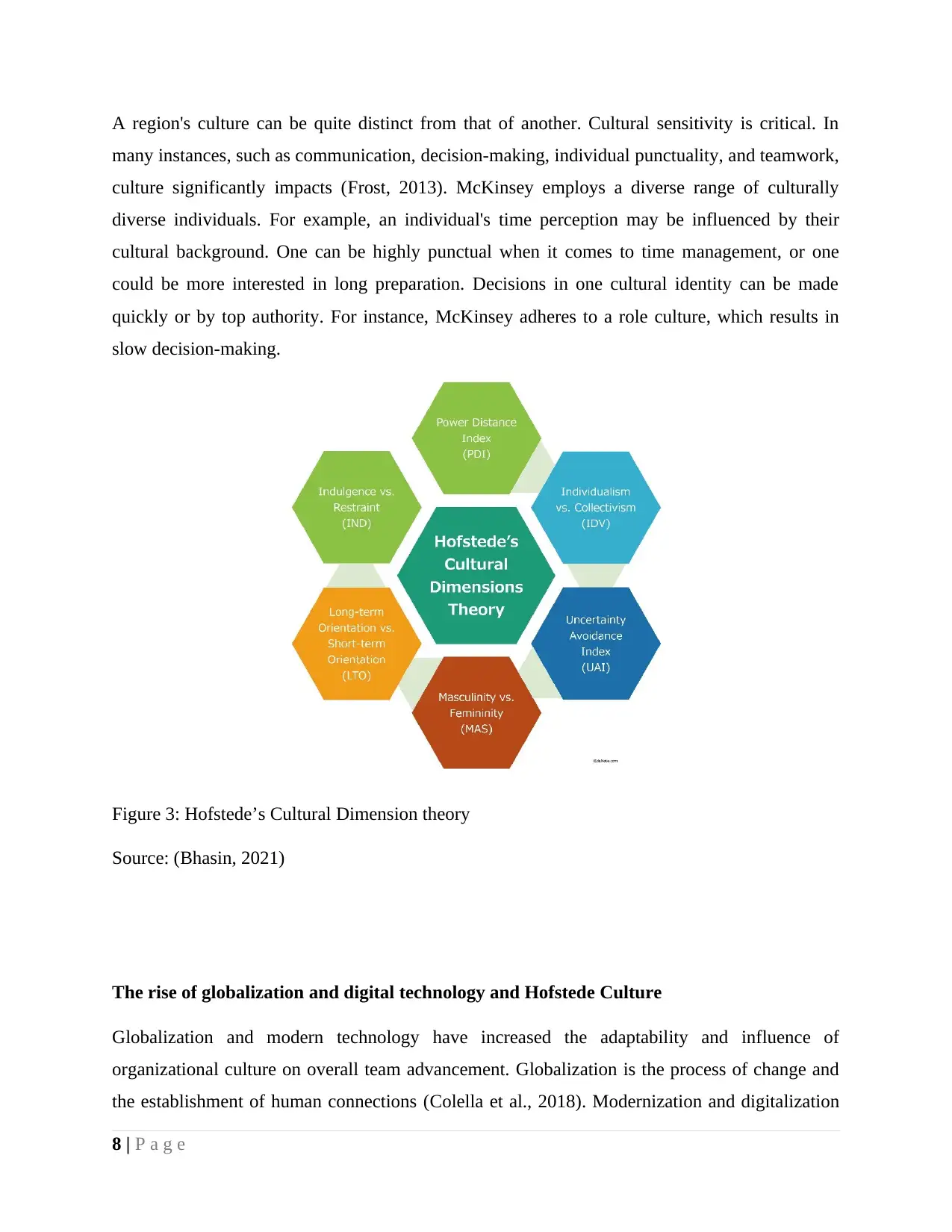
A region's culture can be quite distinct from that of another. Cultural sensitivity is critical. In
many instances, such as communication, decision-making, individual punctuality, and teamwork,
culture significantly impacts (Frost, 2013). McKinsey employs a diverse range of culturally
diverse individuals. For example, an individual's time perception may be influenced by their
cultural background. One can be highly punctual when it comes to time management, or one
could be more interested in long preparation. Decisions in one cultural identity can be made
quickly or by top authority. For instance, McKinsey adheres to a role culture, which results in
slow decision-making.
Figure 3: Hofstede’s Cultural Dimension theory
Source: (Bhasin, 2021)
The rise of globalization and digital technology and Hofstede Culture
Globalization and modern technology have increased the adaptability and influence of
organizational culture on overall team advancement. Globalization is the process of change and
the establishment of human connections (Colella et al., 2018). Modernization and digitalization
8 | P a g e
many instances, such as communication, decision-making, individual punctuality, and teamwork,
culture significantly impacts (Frost, 2013). McKinsey employs a diverse range of culturally
diverse individuals. For example, an individual's time perception may be influenced by their
cultural background. One can be highly punctual when it comes to time management, or one
could be more interested in long preparation. Decisions in one cultural identity can be made
quickly or by top authority. For instance, McKinsey adheres to a role culture, which results in
slow decision-making.
Figure 3: Hofstede’s Cultural Dimension theory
Source: (Bhasin, 2021)
The rise of globalization and digital technology and Hofstede Culture
Globalization and modern technology have increased the adaptability and influence of
organizational culture on overall team advancement. Globalization is the process of change and
the establishment of human connections (Colella et al., 2018). Modernization and digitalization
8 | P a g e
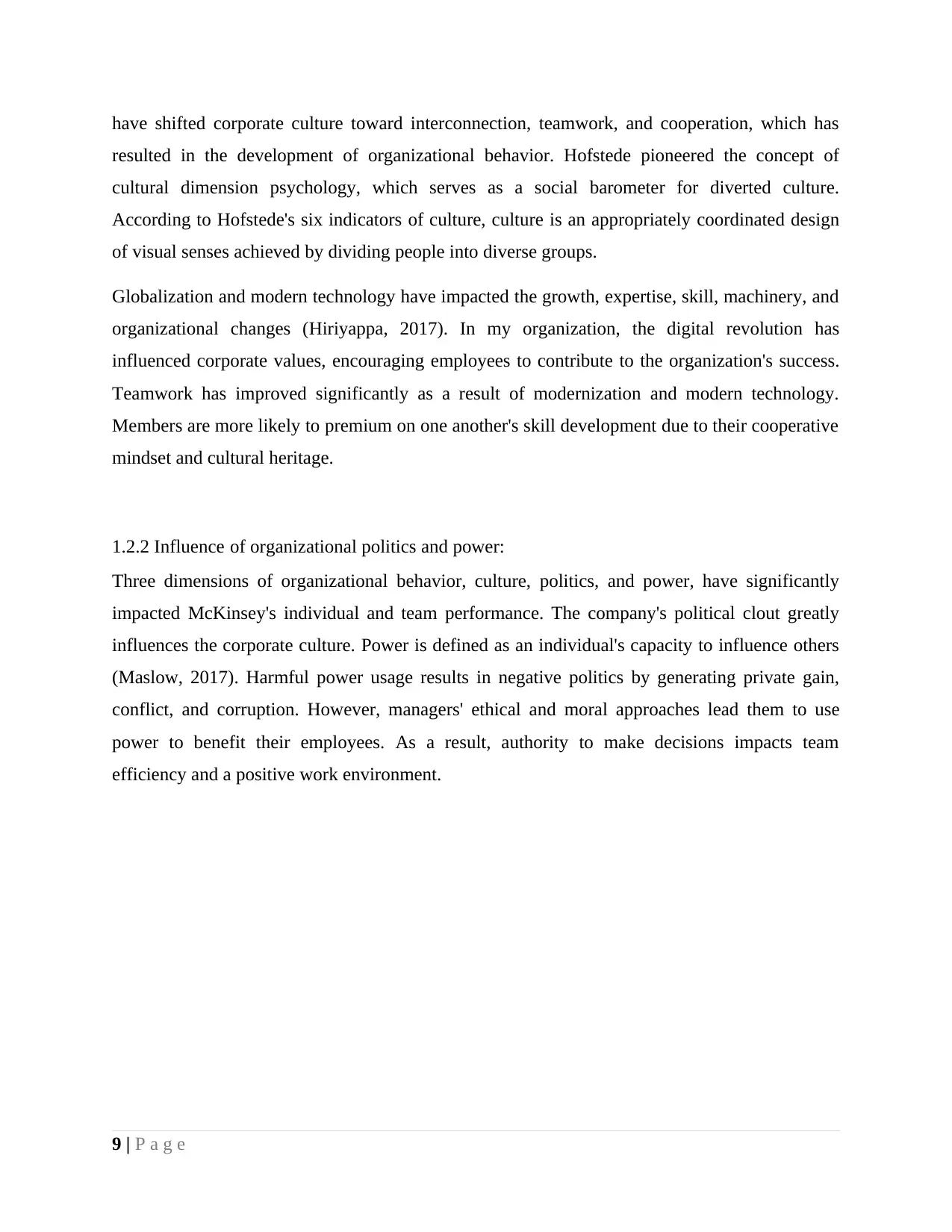
have shifted corporate culture toward interconnection, teamwork, and cooperation, which has
resulted in the development of organizational behavior. Hofstede pioneered the concept of
cultural dimension psychology, which serves as a social barometer for diverted culture.
According to Hofstede's six indicators of culture, culture is an appropriately coordinated design
of visual senses achieved by dividing people into diverse groups.
Globalization and modern technology have impacted the growth, expertise, skill, machinery, and
organizational changes (Hiriyappa, 2017). In my organization, the digital revolution has
influenced corporate values, encouraging employees to contribute to the organization's success.
Teamwork has improved significantly as a result of modernization and modern technology.
Members are more likely to premium on one another's skill development due to their cooperative
mindset and cultural heritage.
1.2.2 Influence of organizational politics and power:
Three dimensions of organizational behavior, culture, politics, and power, have significantly
impacted McKinsey's individual and team performance. The company's political clout greatly
influences the corporate culture. Power is defined as an individual's capacity to influence others
(Maslow, 2017). Harmful power usage results in negative politics by generating private gain,
conflict, and corruption. However, managers' ethical and moral approaches lead them to use
power to benefit their employees. As a result, authority to make decisions impacts team
efficiency and a positive work environment.
9 | P a g e
resulted in the development of organizational behavior. Hofstede pioneered the concept of
cultural dimension psychology, which serves as a social barometer for diverted culture.
According to Hofstede's six indicators of culture, culture is an appropriately coordinated design
of visual senses achieved by dividing people into diverse groups.
Globalization and modern technology have impacted the growth, expertise, skill, machinery, and
organizational changes (Hiriyappa, 2017). In my organization, the digital revolution has
influenced corporate values, encouraging employees to contribute to the organization's success.
Teamwork has improved significantly as a result of modernization and modern technology.
Members are more likely to premium on one another's skill development due to their cooperative
mindset and cultural heritage.
1.2.2 Influence of organizational politics and power:
Three dimensions of organizational behavior, culture, politics, and power, have significantly
impacted McKinsey's individual and team performance. The company's political clout greatly
influences the corporate culture. Power is defined as an individual's capacity to influence others
(Maslow, 2017). Harmful power usage results in negative politics by generating private gain,
conflict, and corruption. However, managers' ethical and moral approaches lead them to use
power to benefit their employees. As a result, authority to make decisions impacts team
efficiency and a positive work environment.
9 | P a g e
⊘ This is a preview!⊘
Do you want full access?
Subscribe today to unlock all pages.

Trusted by 1+ million students worldwide
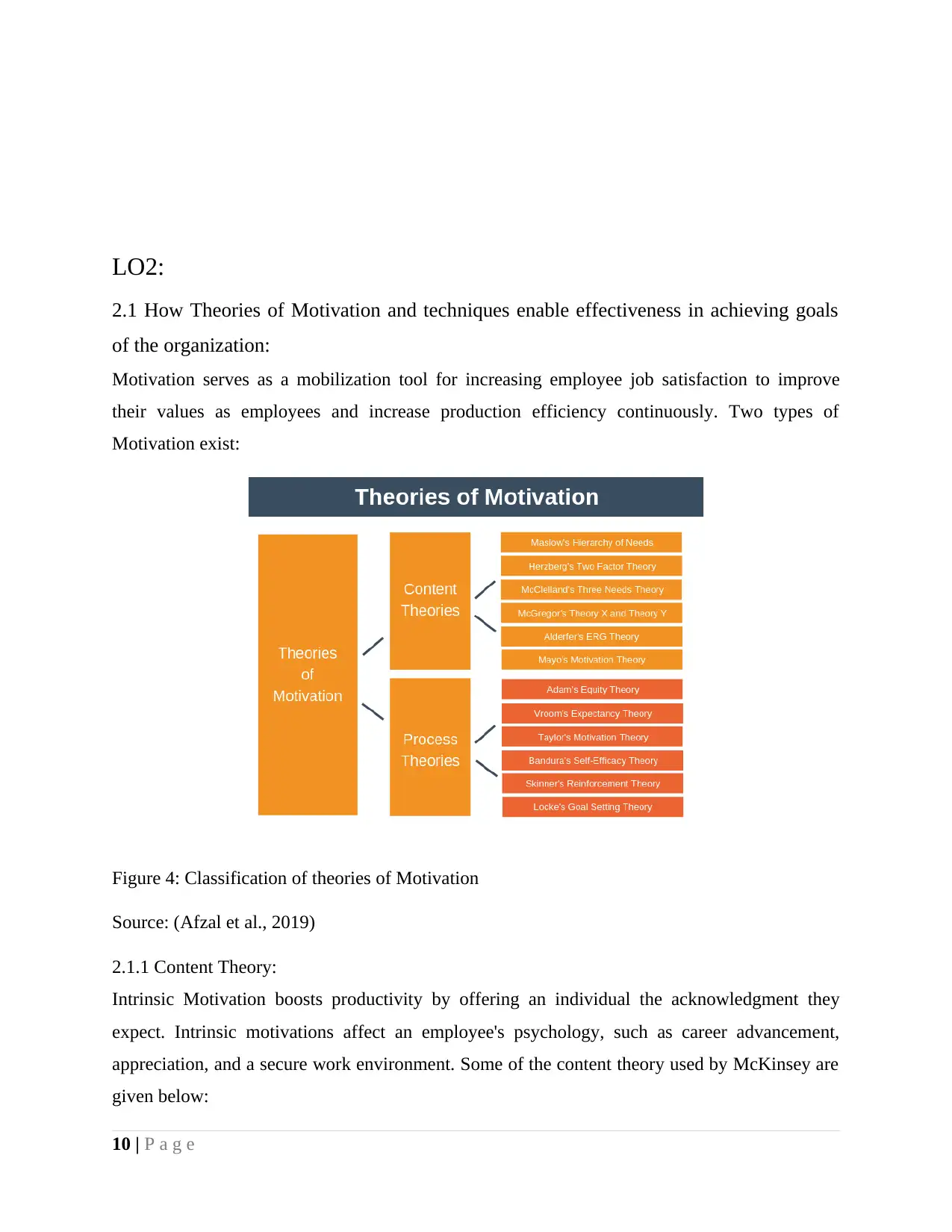
LO2:
2.1 How Theories of Motivation and techniques enable effectiveness in achieving goals
of the organization:
Motivation serves as a mobilization tool for increasing employee job satisfaction to improve
their values as employees and increase production efficiency continuously. Two types of
Motivation exist:
Figure 4: Classification of theories of Motivation
Source: (Afzal et al., 2019)
2.1.1 Content Theory:
Intrinsic Motivation boosts productivity by offering an individual the acknowledgment they
expect. Intrinsic motivations affect an employee's psychology, such as career advancement,
appreciation, and a secure work environment. Some of the content theory used by McKinsey are
given below:
10 | P a g e
2.1 How Theories of Motivation and techniques enable effectiveness in achieving goals
of the organization:
Motivation serves as a mobilization tool for increasing employee job satisfaction to improve
their values as employees and increase production efficiency continuously. Two types of
Motivation exist:
Figure 4: Classification of theories of Motivation
Source: (Afzal et al., 2019)
2.1.1 Content Theory:
Intrinsic Motivation boosts productivity by offering an individual the acknowledgment they
expect. Intrinsic motivations affect an employee's psychology, such as career advancement,
appreciation, and a secure work environment. Some of the content theory used by McKinsey are
given below:
10 | P a g e
Paraphrase This Document
Need a fresh take? Get an instant paraphrase of this document with our AI Paraphraser
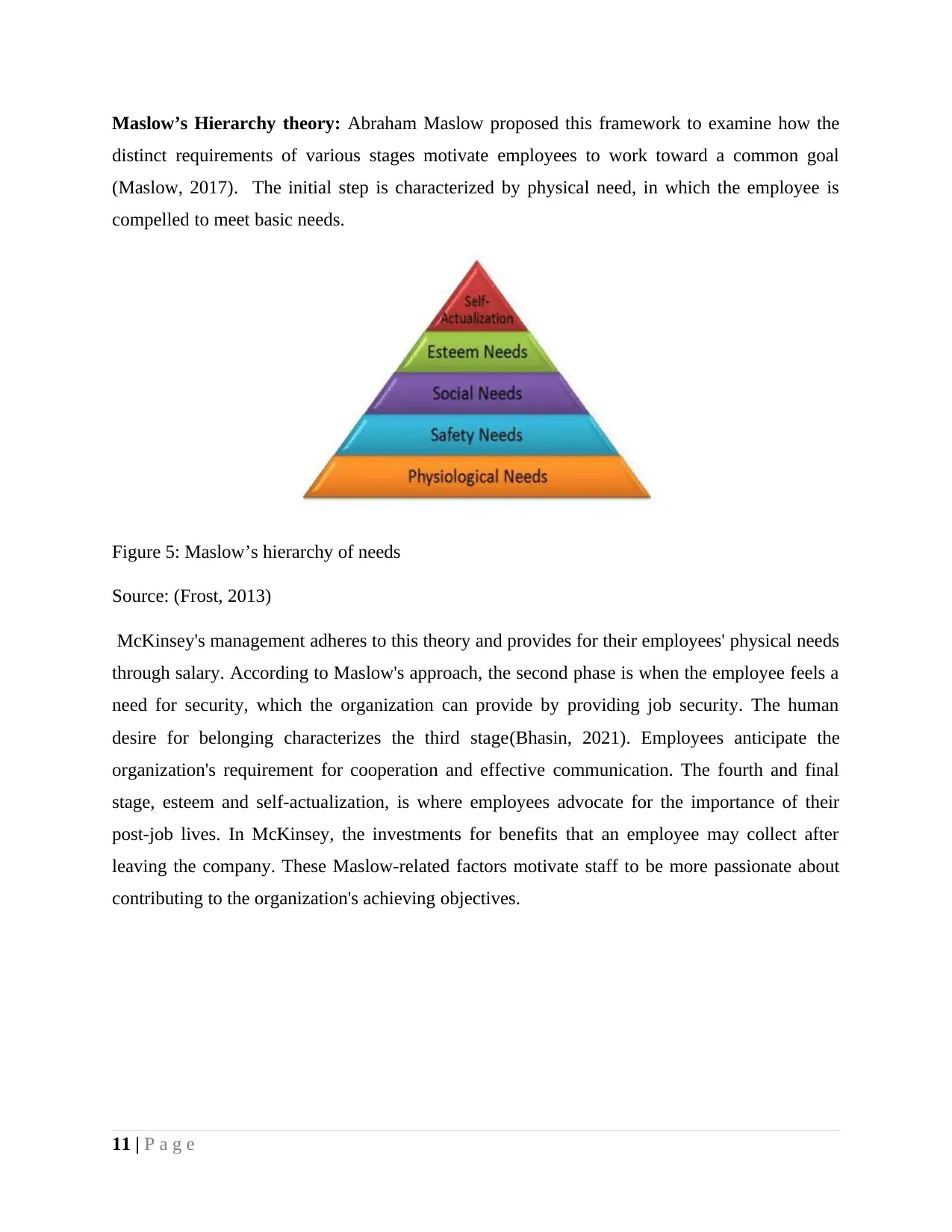
Maslow’s Hierarchy theory: Abraham Maslow proposed this framework to examine how the
distinct requirements of various stages motivate employees to work toward a common goal
(Maslow, 2017). The initial step is characterized by physical need, in which the employee is
compelled to meet basic needs.
Figure 5: Maslow’s hierarchy of needs
Source: (Frost, 2013)
McKinsey's management adheres to this theory and provides for their employees' physical needs
through salary. According to Maslow's approach, the second phase is when the employee feels a
need for security, which the organization can provide by providing job security. The human
desire for belonging characterizes the third stage(Bhasin, 2021). Employees anticipate the
organization's requirement for cooperation and effective communication. The fourth and final
stage, esteem and self-actualization, is where employees advocate for the importance of their
post-job lives. In McKinsey, the investments for benefits that an employee may collect after
leaving the company. These Maslow-related factors motivate staff to be more passionate about
contributing to the organization's achieving objectives.
11 | P a g e
distinct requirements of various stages motivate employees to work toward a common goal
(Maslow, 2017). The initial step is characterized by physical need, in which the employee is
compelled to meet basic needs.
Figure 5: Maslow’s hierarchy of needs
Source: (Frost, 2013)
McKinsey's management adheres to this theory and provides for their employees' physical needs
through salary. According to Maslow's approach, the second phase is when the employee feels a
need for security, which the organization can provide by providing job security. The human
desire for belonging characterizes the third stage(Bhasin, 2021). Employees anticipate the
organization's requirement for cooperation and effective communication. The fourth and final
stage, esteem and self-actualization, is where employees advocate for the importance of their
post-job lives. In McKinsey, the investments for benefits that an employee may collect after
leaving the company. These Maslow-related factors motivate staff to be more passionate about
contributing to the organization's achieving objectives.
11 | P a g e
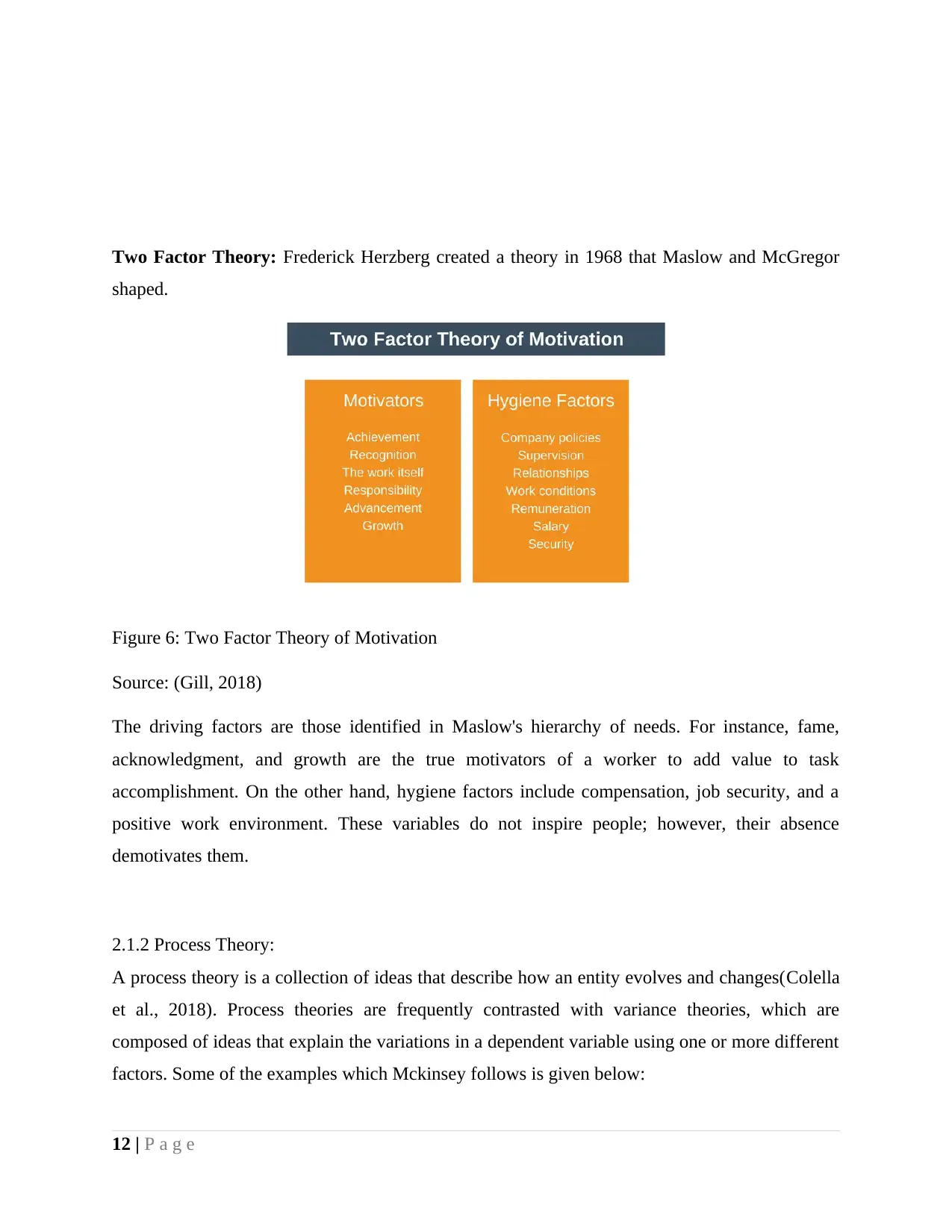
Two Factor Theory: Frederick Herzberg created a theory in 1968 that Maslow and McGregor
shaped.
Figure 6: Two Factor Theory of Motivation
Source: (Gill, 2018)
The driving factors are those identified in Maslow's hierarchy of needs. For instance, fame,
acknowledgment, and growth are the true motivators of a worker to add value to task
accomplishment. On the other hand, hygiene factors include compensation, job security, and a
positive work environment. These variables do not inspire people; however, their absence
demotivates them.
2.1.2 Process Theory:
A process theory is a collection of ideas that describe how an entity evolves and changes(Colella
et al., 2018). Process theories are frequently contrasted with variance theories, which are
composed of ideas that explain the variations in a dependent variable using one or more different
factors. Some of the examples which Mckinsey follows is given below:
12 | P a g e
shaped.
Figure 6: Two Factor Theory of Motivation
Source: (Gill, 2018)
The driving factors are those identified in Maslow's hierarchy of needs. For instance, fame,
acknowledgment, and growth are the true motivators of a worker to add value to task
accomplishment. On the other hand, hygiene factors include compensation, job security, and a
positive work environment. These variables do not inspire people; however, their absence
demotivates them.
2.1.2 Process Theory:
A process theory is a collection of ideas that describe how an entity evolves and changes(Colella
et al., 2018). Process theories are frequently contrasted with variance theories, which are
composed of ideas that explain the variations in a dependent variable using one or more different
factors. Some of the examples which Mckinsey follows is given below:
12 | P a g e
⊘ This is a preview!⊘
Do you want full access?
Subscribe today to unlock all pages.

Trusted by 1+ million students worldwide
1 out of 24
Related Documents
Your All-in-One AI-Powered Toolkit for Academic Success.
+13062052269
info@desklib.com
Available 24*7 on WhatsApp / Email
![[object Object]](/_next/static/media/star-bottom.7253800d.svg)
Unlock your academic potential
Copyright © 2020–2025 A2Z Services. All Rights Reserved. Developed and managed by ZUCOL.





